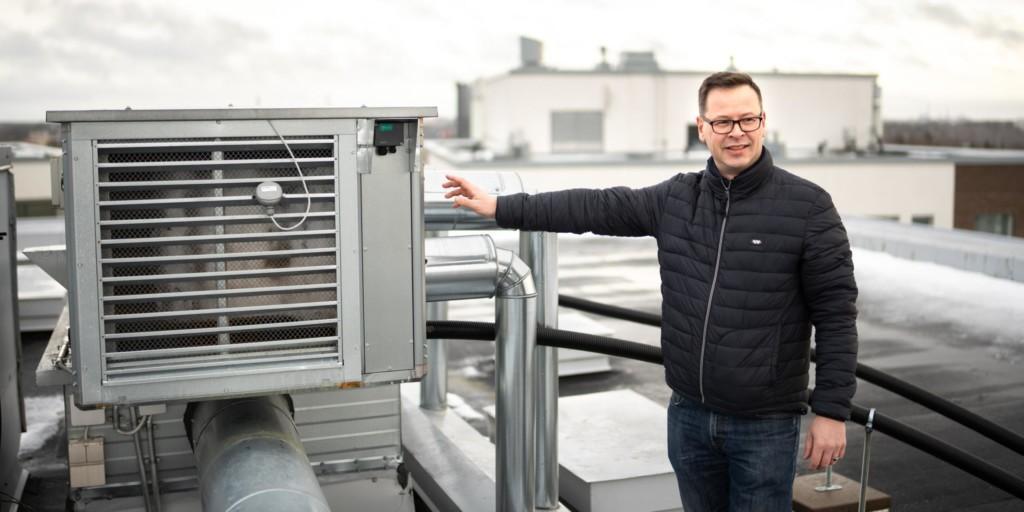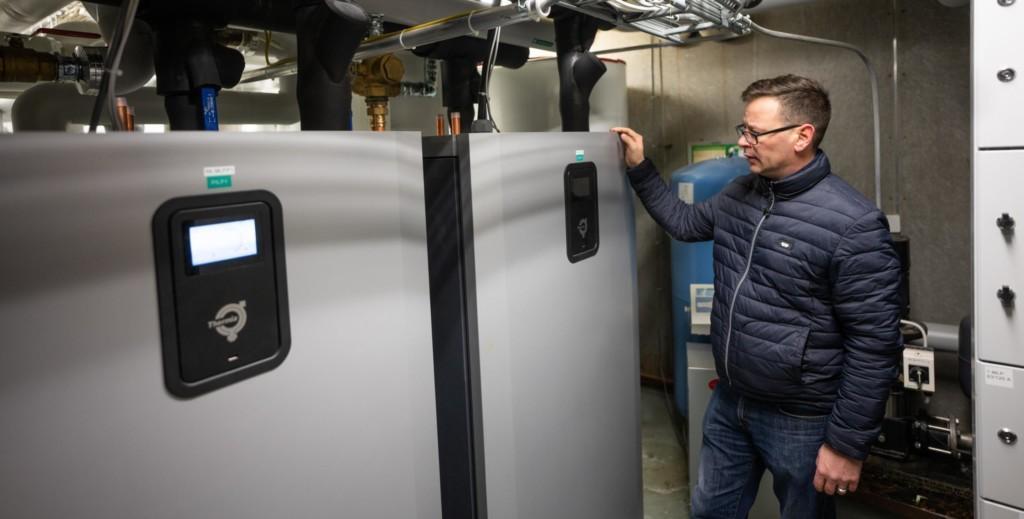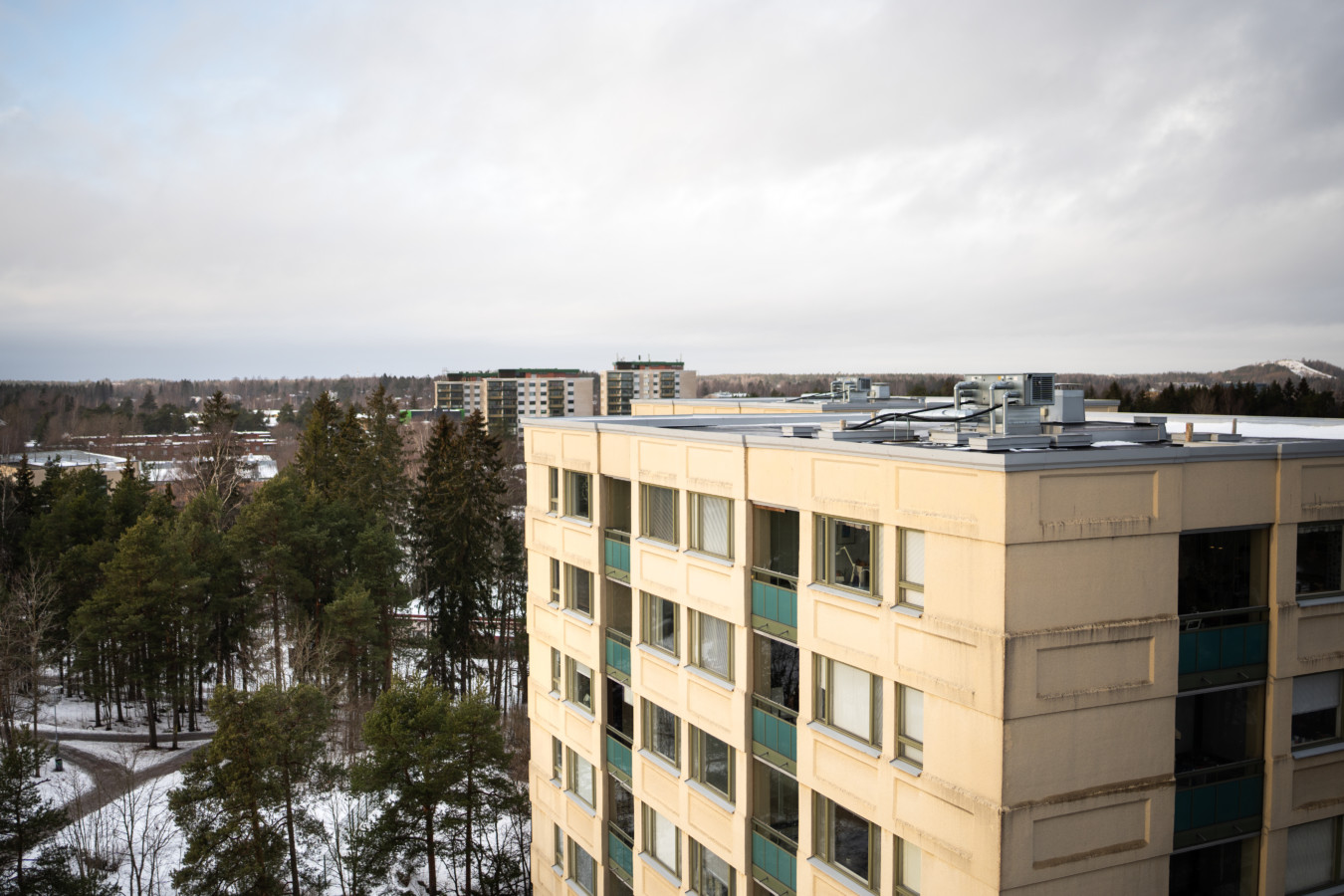In Pitäjänmäki, Helsinki, three eight-storey blocks of flats built in the ’70s sit atop an outcrop, surrounded by woods. On their roofs, machines blow out exceptionally cold air into the winds. The buildings have recently finished their energy renovation.
What was done in the renovation?
The energy renovation consisted of exhaust air heat recovery in the buildings. The housing company has mechanical exhaust ventilation, so the rooftop exhaust fans were replaced at the same time since they were nearing the end of their lifespan.
‘Replacing the equipment would have cost tens of thousands of euros, in any case’, says the president of the Sulkapolku 6 housing company, Markus Tuukkanen.
‘Now, heat is recovered from the exhaust air so efficiently that the roughly 21-degree air finally leaves the building at two degrees Celsius. This way, the heat paid for by the housing company isn’t wasted anymore.

Markus Tuukkanen on the roof of Sulkapolku 6. The heat recovery unit on the left is blowing cold air.
The Sulkapolku 6 housing company has always been strongly motivated to save money and the environment and an energy renovation naturally covered both.
‘The renovation wasn’t one member’s brilliant idea, rather the entire Board was very informed’, says Tuukkanen.
An energy renovation had been in the housing company’s long-term plan for a while, so the shareholders had been aware of it. The annual general meeting had also been told, long before the decision, that the renovation was moving forward. The Board had thus actively informed everyone, which made the decision significantly easier.
In terms of the housing company’s decision-making process, the heat recovery renovation was surprisingly unanimous.
‘The comments were basically just ‘Sounds good!’ and ‘Hear, hear!’ We didn’t have to vote. At the beginning of the general meeting, a representative from Tom Allen [the contractor] was there, matter-of-factly explaining the renovation, without any sales pitches, and providing some background for the decision. We were able to go over the matter rationally, using a numbers approach for what made sense and what didn’t’, says President Tuukkanen.

There are two grey exhaust air heat pumps (on the left in the photo) in the Sulkapolku 6 heat distribution room.
Finding a good partner to provide the services was crucially important in Sulkapolku’s energy project. The housing company wanted a partner that was well-versed in the technology, and who would provide solutions rather than just one device.
In fact, Tuukkanen recommends that housing companies consider the long term when choosing a business partner because the processes can take years, and the equipment has to be maintained after the renovation.
‘If working with the service provider is a struggle from the very beginning, then how could that possibly change?’ says Tuukkanen and continues, ‘In some ways, it’s as important as choosing a partner in a relationship!’
Even though a good partner was found for the energy renovation at Sulkapolku, and the Board was informed and unanimous, the renovation process still took many years. The housing company got the first offers to inform their discussions in 2014, and the renovation was finally finished in 2018. There were surprising delays due to external factors, such as the building control’s policy on the placement of heat collection pipes, as well as Helen’s dimensioning of district heating.
Was the renovation worth it?
The energy renovation has been cost-effective for the housing company: each year, they save roughly 30,000 euros in decreased heating costs.
‘If our baseline in 2018 was about 100,000 euros per year in heating costs, and we’ve lowered our consumption by 30%, that makes about 30,000 per year. The cost of heating has increased a lot since then,’ explains Tuukkanen.
The repayment period was originally calculated to be seven years, but now it’s closer to six. The more the price of district heating increases, the more economical the renovation becomes. It was important to the housing company that the energy renovation relieved some of the pressure to raise maintenance charges.
What advice does Sulkapolku 6 have for other housing companies that are mulling over starting this kind of renovation?
‘If the renovation is even slightly economical, then why not carry it out? I understand that you have to weigh things differently if the repayment period is 20 years or more, but if there’s a reasonable repayment period, why on earth wouldn’t you do it? Why was the renovation not done last year? The thing that bothers us the most is that we were delayed a year. We had unnecessary expenses because we couldn’t start saving earlier. We regret not starting years ago!’ Tuukkanen laughs.
The next renovations are already on the horizon in Sulkapolku 6’s long-term plan: geothermal heat and waste water heat recovery have been considered.

The exhaust air heat recovery renovation on the roof of Sulkapolku 6 might only be visible to magpies, but the shareholders definitely feel it in their wallets.
Markus Tuukkanen’s tips for housing companies
- Include energy renovations in your long-term plan well ahead of time, and tell the shareholders about them.
- Find a good business partner who you can work with in the future, too.
- Start now and not tomorrow – the process takes time!
Housing Company Sulkapolku 6
- Buildings: Three eight-storey blocks of flats
- Year of construction: 1973
- Units: 144
- Heating energy consumption with district heating: 1 500 MWh/year
- Heating energy consumption with exhaust air heat recovery: district heating app. 900 MWh/year, electricity app. 140 MWh/year (the exhaust air heat pump uses electricity when it moves heat from the exhaust air into the radiator network)
- • Heating energy savings: app. 460 MWh/year
More information
Do you want to carry out an energy renovation in your housing company in Helsinki? Contact the city’s energy experts for free advice. Read more »
Article photos: Jussi Rekiaro
This article was originally published in Finnish on 9 February 2022.

